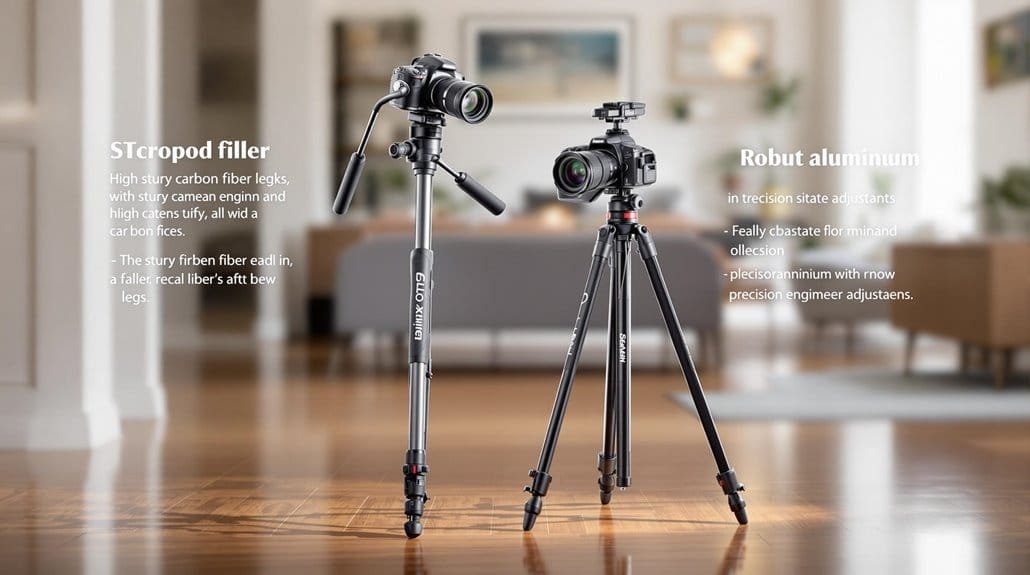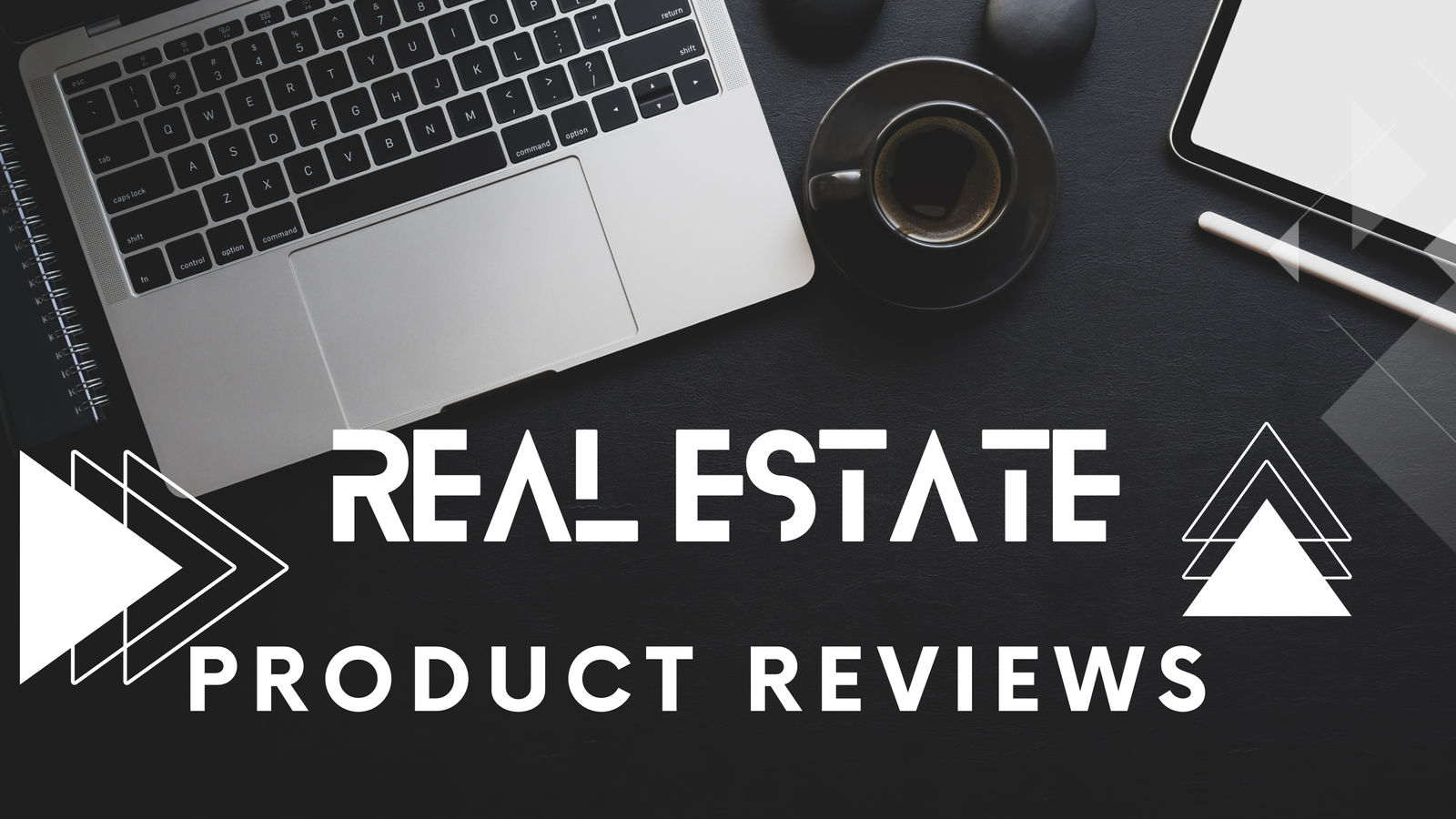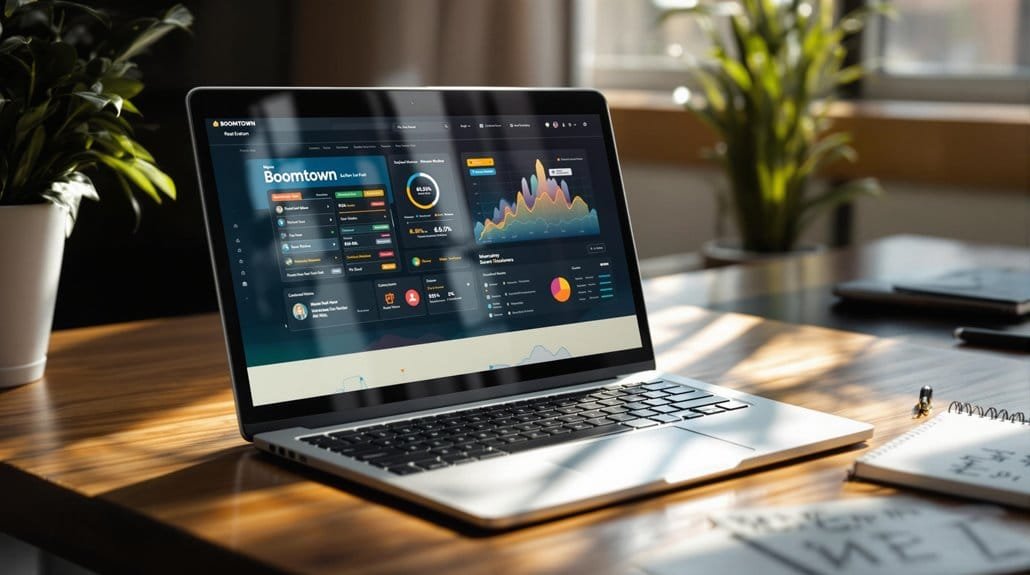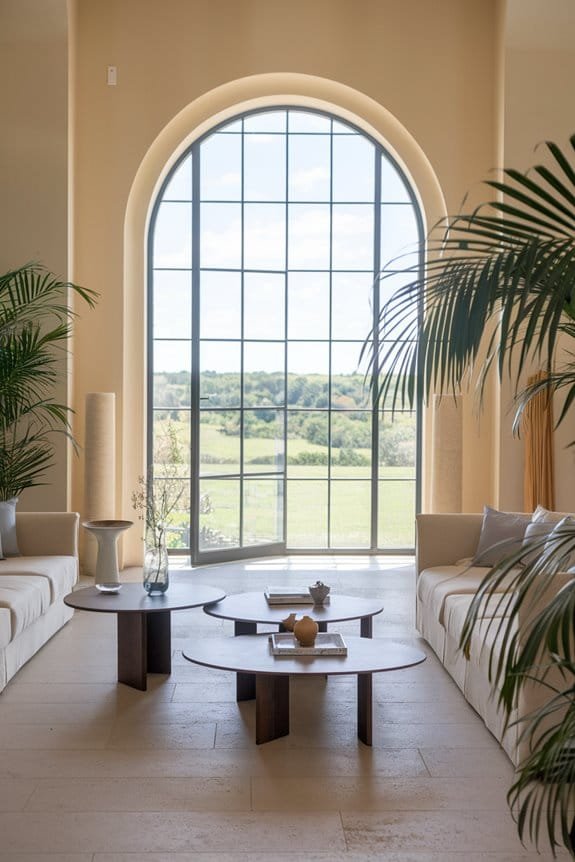For real estate photography, the K&F Concept 64-inch tripod and the 72-inch Tall Tripod with remote are two excellent choices. The K&F tripod is lightweight, sturdy, and adjusts from 20.4 to 64.1 inches, perfect for a variety of angles. With a 360-degree ball head, it allows for precise positioning. The 72-inch tripod also offers versatility, transforming into a monopod and featuring a Bluetooth remote for seamless shots. Both models provide exceptional stability and durability, essential for long exposure photos. If you’re keen to explore other options and tips, you might find what’s next particularly enlightening.
Key Takeaways
- The K&F Concept 64 inch Tripod supports up to 17.6 pounds, ensuring stability for DSLRs during long exposure shots in real estate photography.
- Its adjustable height range of 20.4 to 64.1 inches allows for versatile angles, showcasing properties effectively from different perspectives.
- The 360-degree metal ball head provides smooth repositioning, enabling precise camera movements for expansive shots in tight spaces.
- The 72″ Tall Tripod with Remote features a quick conversion to a monopod, enhancing mobility for dynamic shooting scenarios in real estate.
- Both tripods are lightweight and compact, making them easy to transport between properties without sacrificing stability or precision.
K&F Concept 64 inch Camera Tripod
- 【Lightweight and Portable】4 section leg can adjust tripod height from 20.4”/52cm to 64.1”/163cm; it can be folded to 1…
- 【360 Degree Ball Head】36mm ball head can be rotated to any angle you want, helping to improve the range of camera activi…
- 【Efficient and Flexible】With powerful and quick flip leg lock, only use one hand can open and close all the buttons in a…
The K&F Concept 64 inch Camera Tripod (K234A0+BH-28L) is an excellent choice for real estate photographers who need a lightweight yet sturdy option that supports a variety of cameras. Weighing only 2.53 pounds, this tripod can handle up to 17.6 pounds, making it ideal for DSLRs, smartphones, and even projectors. Its adjustable height ranges from 20.4 inches to 64.1 inches, providing versatility for different shooting angles. You’ll appreciate the 360-degree metal ball head for easy repositioning, while the quick flip leg locks allow for swift setup. Plus, its compact design folds to just 15.3 inches, fitting snugly in your carry-on. With positive user feedback on stability and performance, this tripod truly represents exceptional value for both photography and videography.
Best For: Real estate photographers seeking a lightweight, versatile tripod that supports various cameras and provides stability in different shooting conditions.
Pros:
- Lightweight design at only 2.53 pounds allows for easy transport and travel.
- Versatile height adjustment from 20.4 to 64.1 inches enables various shooting angles.
- Sturdy construction supports a load capacity of up to 17.6 pounds, accommodating DSLRs and projectors.
Cons:
- Sharp burrs on bolts may pose a safety concern during setup.
- Ineffective bubble level can lead to imprecise adjustments in camera positioning.
- Lack of a panhandle limits vertical panning capabilities for certain shots.
Camera Tripod, 72″ Tall with Remote
- LIGHTWEIGHT FOR TRAVEL:Compactness when stored and weighs only 3.3 lbs/1.5 kilograms, easy to move around with a strappe…
- UPGRADED SOLID CONSTRUCTION: Made of aluminum alloy, THICKER leg tube than the ordinary tripod, sturdy adequate for long…
- TRIPOD AND MONOPOD COMBINED UNIT: Takes about 5 seconds to go from the tripod into 55in monopod and reduces the weight o…
For real estate photographers seeking a reliable and versatile tool, the 72″ tall camera tripod with a remote offers exceptional stability and convenience. Weighing just 3.3 lbs, this aluminum alloy tripod provides sturdiness with thicker leg tubes, ensuring it remains stable even during long exposure shots. You can easily adjust its height from 21 to 72 inches, making it perfect for various photography scenarios, including indoor and outdoor settings. The tripod converts to a monopod in seconds, enhancing its usability. Additionally, the Bluetooth remote allows for effortless camera operation, ensuring you capture the perfect shot without needing to run back and forth. With its impressive features and reasonable price, this tripod is an excellent choice for both amateur and professional photographers alike.
Best For: This tripod is best for amateur and professional photographers who need a reliable and versatile tool for indoor and outdoor photography.
Pros:
- Pros:
- Lightweight design at just 3.3 lbs, making it easy to carry for travel.
- Quick conversion between tripod and monopod enhances usability for various photography needs.
- Bluetooth remote included for convenient camera operation, reducing the need for physical adjustments.
Cons:
- Cons:
- Not recommended for heavy telephoto lenses, which may affect stability.
- Some users find the instruction pamphlet’s print too small for easy reading.
- The carrying bag might be a bit small, requiring careful packing to fit the collapsed tripod.
Factors to Consider When Choosing Camera Tripods for Real Estate
When you’re choosing a camera tripod for real estate photography, several key factors come into play. You’ll want to think about height adjustability, as it helps you capture different angles of a property, while weight and portability are essential for easy transport between locations. Additionally, consider stability for long exposures, the type of head and its functionality, and the material’s durability to guarantee your equipment can withstand various shooting conditions.
Height Adjustability Importance
How important is height adjustability in real estate photography? Height adjustability plays a significant role in capturing a range of angles and perspectives that showcase properties effectively. When you use a tripod with a height range of at least 60 inches, you can achieve eye-level shots that are necessary for highlighting interiors. Conversely, being able to lower your tripod to around 20 inches opens up opportunities for low-angle shots, adding depth and dimension to your photos.
Moreover, adjustable height legs are invaluable, especially when you’re working on uneven terrain; they guarantee your tripod remains stable, allowing for consistent framing and composition in outdoor settings. This stability is essential when you’re trying to convey the true essence of a property.
Additionally, consider tripods that can transform into monopods. This feature provides versatile height options and enhances mobility, enabling you to make quick adjustments during property walkthroughs. With these considerations in mind, height adjustability becomes not just a feature but a key factor in your real estate photography toolkit, allowing you to capture properties in the best light possible.
Weight and Portability Factors
Capturing stunning real estate photos requires not just height adjustability but also careful consideration of weight and portability. When choosing a tripod, think about its weight; lighter models around 2.53 lbs are much easier to transport and set up in various locations, especially when you’re hopping from one property to another.
Portability is enhanced by compact designs that fold down to less than 16 inches, making it convenient to carry in your backpack or vehicle. Look for tripods with quick flip leg locks, allowing for efficient setup and adjustments—this feature is particularly important when you need to adapt to different room sizes and angles on the fly.
Additionally, guarantee your tripod has a load capacity of at least 8 kg (17.6 lbs), providing stability for heavier camera setups or added accessories you might use in real estate photography. Finally, consider tripods that can double as monopods; this versatility keeps your gear lightweight while expanding your shooting options. By selecting a tripod that balances weight and portability, you’ll streamline your workflow and enhance your photography experience.
Stability for Long Exposures
To achieve sharp, detailed images during long exposure photography, stability is essential. When selecting a tripod, consider one with a high load capacity, ideally around 8kg or 17.6lbs. This guarantees your camera stays steady throughout extended exposure times, preventing unwanted blurriness. Sturdy construction is equally important; materials like aluminum alloy greatly enhance stability while minimizing vibrations that can disrupt your shots.
Look for additional features, such as a hook on the center post. This allows you to add extra weight, further increasing stability, especially useful in windy conditions. Also, a tripod with quick flip leg locks can be a game-changer, enabling you to swiftly adjust the height and secure the setup across various terrains.
Lastly, utilizing a tripod with a 360-degree ball head gives you the flexibility to position your camera precisely. This versatility is essential for composing long exposure shots without sacrificing stability. In real estate photography, where capturing the essence of a space is fundamental, making sure your equipment allows for maximum stability during long exposures can make all the difference in the quality of your final images.
Head Type and Functionality
Achieving stability during long exposures is only part of the equation in real estate photography; the type of tripod head you choose can greatly influence your shooting experience. For instance, ball heads are popular among photographers because they allow for smooth 360-degree rotation and precise positioning, making them ideal for capturing wide-angle shots of property interiors and exteriors. If you prefer versatility, a 3-way swivel head enables independent control over pan, tilt, and rotation, which can help you frame your shots perfectly.
Another important feature is the quick release plate, which allows for efficient camera attachment and detachment. This is essential when you’re shifting quickly between shots, particularly in dynamic environments like open houses. Stability features, such as built-in bubble levels and hooks for additional weight, enhance performance during long exposures, minimizing the risk of camera shake while highlighting intricate property details.
Additionally, the ability to adjust the tripod’s height lets you capture a range of angles and perspectives, showcasing real estate in the best light. By paying attention to head type and functionality, you’ll find a tripod that meets your specific needs and elevates your photography.
- Prepare for Loan Maturities and Refinancing Waves as a Real Estate AgentIn mastering loan maturities and refinancing waves, uncover strategies every real estate agent needs to empower clients during pivotal financial transitions.
Material Durability Considerations
Durability is an important factor when selecting a tripod for real estate photography, as it directly impacts your shooting experience. The material of the tripod plays a notable role in its overall durability. Aluminum alloys are a great choice because they offer a robust structure while remaining lightweight. Unlike heavier materials like steel, high-quality aluminum can handle heavier loads without bending, which is vital when using professional-grade cameras and lenses.
Also, consider the thickness of the leg tubes. Thicker tubes enhance stability and resist flexing under load, helping you maintain sharp images during long exposures. If you’re shooting in various environments, look for tripods with weather-resistant coatings. These coatings protect against moisture and corrosion, extending the tripod’s lifespan.
Lastly, regular maintenance is key to durability. Checking for wear on locking mechanisms and cleaning joints can greatly enhance your tripod’s performance over time. By paying attention to these material durability considerations, you’ll guarantee that your tripod not only meets your needs but stands the test of time, providing you with the stability and precision vital for capturing stunning real estate photographs.
Versatility for Various Cameras
Versatility is a game-changer when choosing a tripod for real estate photography. You want a tripod that’s compatible with various camera types, including DSLRs, mirrorless cameras, and even smartphones. Look for models equipped with a standard 1/4 inch thread to guarantee compatibility.
Height adjustability is another vital factor; select a tripod that can extend from about 20 inches to over 70 inches tall. This flexibility allows you to capture diverse shooting angles and perspectives, which is essential in showcasing properties effectively.
A 360-degree swivel head is a must for smooth panning and tilting, enabling you to take expansive interior and exterior shots without introducing distortion. Plus, consider tripods that can double as monopods. This feature makes quick shifts between different shooting scenarios a breeze, saving you time on the job.
Lastly, prioritize lightweight and compact designs. As a real estate professional, you’ll frequently move between properties, so having a portable tripod will make your life a lot easier. Investing in a versatile tripod not only enhances your photography but also elevates your professional presence in the competitive real estate market.
Recent Posts

Canon EOS R8 Review

How to Stay Organized With Multiple Real Estate Transactions
Quick Setup Mechanisms
When you’re on a real estate shoot, time is often of the essence, and having a tripod with quick setup mechanisms can make all the difference. Look for models featuring flip leg locks, as they allow for rapid deployment, essential in fast-paced environments where every second counts. Adjustable heights and quick-release plates let you easily adapt to different shooting angles and compositions, ensuring you capture the perfect shot with minimal hassle.
Additionally, a tripod with a 360-degree swivel head enables smooth panning and tilting. This is particularly useful for wide-angle shots of interiors or exteriors, allowing you to shift seamlessly between angles without delays. If you often find yourself needing versatility, consider tripods that can quickly switch between tripod and monopod configurations. This feature is invaluable for stable shots and dynamic angles, enhancing your ability to showcase properties effectively.
Don’t underestimate the importance of portability, either. A compact design and lightweight materials make transport a breeze, enabling quick setups in various locations without compromising stability or usability. With these quick setup mechanisms, you’ll be ready to focus on what truly matters: capturing stunning images that highlight the beauty of each property.
Budget-Friendly Options Available
Finding a budget-friendly tripod that meets your needs for real estate photography can be a challenge, but it’s definitely possible with a little research. Start by looking for tripods with a height range of at least 60 inches; this will help you capture diverse angles in spacious interiors. You’ll also want to take into account weight—models under 3.5 lbs are ideal for easy transport, allowing you to move quickly between listings without sacrificing stability.
Don’t overlook the load capacity, either. A tripod that can support at least 8 kg guarantees it can handle the heavier DSLR cameras and lenses typical in real estate work. Quick-release plates are another feature to prioritize; they make camera setup and adjustments faster, which is vital when you’re on a tight schedule during property tours.
Lastly, think about tripods that can convert into monopods. This added versatility is perfect for capturing dynamic shots in tighter spaces or outdoor settings, eliminating the need for multiple pieces of equipment. By keeping these factors in mind, you can find a budget-friendly tripod that meets your real estate photography needs without breaking the bank.
Frequently Asked Questions
Can I Use These Tripods for Video Recording?
Yes, you can use these tripods for video recording. They provide excellent stability and precision, which are essential for capturing smooth, professional-looking footage. Just make sure that the tripod’s weight capacity supports your camera and any additional gear. If you’re using a fluid head, it’ll allow for better panning and tilting, enhancing your video’s overall quality. So, whether you’re filming real estate or other projects, these tripods can serve your needs effectively.
What Weight Capacity Do These Tripods Support?
When considering the weight capacity of tripods, you’ll find that it varies considerably between models. Generally, most sturdy tripods can support anywhere from 15 to 30 pounds, which is perfect for standard camera setups. However, always check the manufacturer’s specifications for precise limits. If you plan to use heavier equipment, look for tripods specifically designed for greater stability and weight support, ensuring safety and ideal performance during your shoots.
Are These Tripods Portable for Outdoor Shoots?
Yes, these tripods are designed for portability, making them ideal for outdoor shoots. They typically feature lightweight materials, such as aluminum or carbon fiber, allowing you to easily carry them without sacrificing stability. Many models also come with compact folding designs, which enable you to pack them in your gear bag. This combination of lightness and compactness guarantees you can set up quickly and efficiently, capturing stunning shots wherever your photography takes you.
Do They Come With a Carrying Case?
Yes, both tripods typically come with a carrying case, making them convenient for transport. This feature is especially beneficial for outdoor shoots or location work, as it protects your equipment and allows for easy mobility. When you’re on the go, having a durable case guarantees your tripod remains in good condition, ready for use whenever you need it. Plus, it adds an extra layer of organization to your photography gear.
How Do I Maintain and Clean My Tripod?
To maintain and clean your tripod, start by wiping down the legs and head with a soft, lint-free cloth to remove dust and dirt. Check for any sand or debris in the locking mechanisms, and use compressed air to blow it out if needed. Inspect the rubber feet for wear and replace them if necessary. Finally, store your tripod in a dry place, ideally in a carrying case, to prevent damage during transport.
Bottom Line
In choosing the right tripod for real estate photography, both the K&F Concept 64-inch tripod and the 72-inch remote model offer exceptional stability and precision. Remember to contemplate height adjustability, weight, and material durability, as well as versatility and ease of setup. Investing in a quality tripod not only enhances your photography but also reflects your professionalism. With these tripods, you’ll be well-equipped to capture stunning property images that stand out in today’s competitive market.









